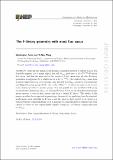The F-theory geometry with most flux vacua
Author(s)
Taylor, Washington; Wang, Yinan
Download13130_2015_Article_2795.pdf (449.7Kb)
PUBLISHER_CC
Publisher with Creative Commons License
Creative Commons Attribution
Terms of use
Metadata
Show full item recordAbstract
Applying the Ashok-Denef-Douglas estimation method to elliptic Calabi-Yau fourfolds suggests that a single elliptic fourfold M[subscript max] gives rise to O(10[superscript 272,000]) F-theory flux vacua, and that the sum total of the numbers of flux vacua from all other F-theory geometries is suppressed by a relative factor of O(10[superscript −3000]). The fourfold M[subscript max] arises from a generic elliptic fibration over a specific toric threefold base B max, and gives a geometrically non-Higgsable gauge group of E [subscript 8] [superscript 9] × F [subscript 4] [superscript 8] × (G [subscript 2] × SU(2))[superscript 16], of which we expect some factors to be broken by G-flux to smaller groups. It is not possible to tune an SU(5) GUT group on any further divisors in M[subscript max], or even an SU(2) or SU(3), so the standard model gauge group appears to arise in this context only from a broken E 8 factor. The results of this paper can either be interpreted as providing a framework for predicting how the standard model arises most naturally in F-theory and the types of dark matter to be found in a typical F-theory compactification, or as a challenge to string theorists to explain why other choices of vacua are not exponentially unlikely compared to F-theory compactifications on M[subscript max].
Date issued
2015-12Department
Massachusetts Institute of Technology. Center for Theoretical Physics; Massachusetts Institute of Technology. Department of PhysicsJournal
Journal of High Energy Physics
Publisher
Springer Berlin Heidelberg
Citation
Taylor, Washington, and Yi-Nan Wang. “The F-Theory Geometry with Most Flux Vacua.” Journal of High Energy Physics 2015.12 (2015): n. pag.
Version: Final published version
ISSN
1029-8479